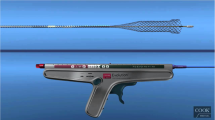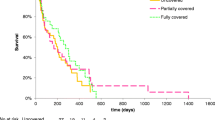Abstract
Objective
To investigate whether covered stents show a higher efficacy than uncovered stents in percutaneous treatment of malignant hilar biliary obstruction.
Methods
Patients with obstructive jaundice caused by an unresectable hilar malignancy were included after failed endoscopic intervention in a prospective randomized trial comparing expanded polytetrafluoroethylene and fluorinated ethylene propylene (ePTFE-FEP)–covered nitinol stents with uncovered nitinol stents. Exclusion criteria were as follows: primary tumors existing more than 3 months, a biliodigestive anastomosis, previous stenting, and a Karnofsky score of less than 50. Safety, clinical success, and adjuvant chemotherapy were compared as well as occlusion rate, patency, and survival.
Results
A total of 120 patients were included. One patient was post hoc excluded. Fourteen patients who died within 7 days and one patient without patency data were excluded from patency analysis. Serious adverse events (p = 0.4), 30-day mortality (p = 0.5), and clinical success (p = 0.8) were equivalent for both stent groups. Twenty-one out of 61 (34%) patients in the covered and 24/58 (41%) in the uncovered stent groups received adjuvant chemotherapy (p = 0.5). Occlusion rate was 54% (27/50) in the covered stent group and 57% (31/54) in the uncovered stent group (p = 0.8). Median patency was 229 days (95% CI 113–345) for covered stents and 130 days (95% CI 75–185) for uncovered stents (p = 0.1). Median survival in patients with covered stents was 79 days (95% CI 52–106) and with uncovered stents 92 days (95% CI 60–124) (p = 0.3).
Conclusion
In malignant hilar biliary obstruction, there is no evidence that ePTFE-FEP-covered stents are superior to uncovered stents in terms of safety, clinical success, adjuvant chemotherapy, patency, or survival.
Key Points
• Percutaneous palliation of hilar biliary obstruction is feasible with both uncovered and covered stents.
• Clinical success in terms of bilirubin decrease and adjuvant chemotherapy is achievable with both stents.
• Thirty-day mortality is considerable when stenting is also offered to patients with a low performance status.






Similar content being viewed by others
Change history
06 July 2020
On request from the Editors, the authors would like to clarify the following: the patient cohorts in the publications ���No evidence of improved efficacy of covered stents over uncovered stents in percutaneous palliation of malignant hilar biliary obstruction: results of a prospective randomized trial���.
Abbreviations
- ePTFE-FEP:
-
Expanded polytetrafluoroethylene and fluorinated ethylene propylene
- ERCP:
-
Endoscopic retrograde cholangiopancreatography
- HR:
-
Hazard ratio
- MRCP:
-
Magnetic resonance cholangiopancreatography
- PTC:
-
Percutaneous transhepatic cholangiography
- RCT:
-
Randomized controlled trial
- SAE:
-
Serious adverse event
- SEMS:
-
Self-expandable metal stent
- SIR:
-
Society of Interventional Radiology
References
Jarnagin WR, Fong Y, DeMatteo RP et al (2001) Staging, resectability, and outcome in 225 patients with hilar cholangiocarcinoma. Ann Surg 234(4):507–517 discussion 517
Vandenabeele LAM, Dhondt E, Geboes KP, Defreyne L (2017) Percutaneous stenting in malignant biliary obstruction caused by metastatic disease: clinical outcome and prediction of survival according to tumor type and further therapeutic options. Acta Gastroenterol Belg 80(2):249–255
Sellier F, Bories E, Sibertin-Blanc C et al (2017) Clinical outcome after biliary drainage for metastatic colorectal cancer: survival analysis and prognostic factors. Dig Liver Dis 50(2):189–194
De Palma GD, Galloro G, Siciliano S, Iovino P, Catanzano C (2001) Unilateral versus bilateral endoscopic hepatic duct drainage in patients with malignant hilar biliary obstruction: results of a prospective, randomized, and controlled study. Gastrointest Endosc 53(6):547–553
Davids PH, Groen AK, Rauws EA, Tytgat GN, Huibregtse K (1992) Randomised trial of self-expanding metal stents versus polyethylene stents for distal malignant biliary obstruction. Lancet 340(8834–8835):1488–1492
Liberato MJ, Canena JM (2012) Endoscopic stenting for hilar cholangiocarcinoma: efficacy of unilateral and bilateral placement of plastic and metal stents in a retrospective review of 480 patients. BMC Gastroenterol 12:103
Inal M, Akgül E, Aksungur E, Seydaoğlu G (2003) Percutaneous placement of biliary metallic stents in patients with malignant hilar obstruction: unilobar versus bilobar drainage. J Vasc Interv Radiol 14(11):1409–1416
Mukai T, Yasuda I, Nakashima M et al (2013) Metallic stents are more efficacious than plastic stents in unresectable malignant hilar biliary strictures: a randomized controlled trial. J Hepatobiliary Pancreat Sci 20(2):214–222
Isayama H, Komatsu Y, Tsujino T et al (2002) Polyurethane-covered metal stent for management of distal malignant biliary obstruction. Gastrointest Endosc 55(3):366–370
Isayama H, Komatsu Y, Tsujino T et al (2004) A prospective randomised study of “covered” versus “uncovered” diamond stents for the management of distal malignant biliary obstruction. Gut 53(5):729–734
Krokidis M, Fanelli F, Orgera G, Bezzi M, Passariello R, Hatzidakis A (2010) Percutaneous treatment of malignant jaundice due to extrahepatic cholangiocarcinoma: covered Viabil stent versus uncovered wall stents. Cardiovasc Intervent Radiol 33(1):97–106
Kitano M, Yamashita Y, Tanaka K et al (2013) Covered self-expandable metal stents with an anti-migration system improve patency duration without increased complications compared with uncovered stents for distal biliary obstruction caused by pancreatic carcinoma: a randomized multicenter trial. Am J Gastroenterol 108(11):1713–1722
Kullman E, Frozanpor F, Söderlund C et al (2010) Covered versus uncovered self-expandable nitinol stents in the palliative treatment of malignant distal biliary obstruction: results from a randomized, multicenter study. Gastrointest Endosc 72(5):915–923
Telford JJ, Carr-Locke DL, Baron TH et al (2010) A randomized trial comparing uncovered and partially covered self-expandable metal stents in the palliation of distal malignant biliary obstruction. Gastrointest Endosc 72(5):907–914
Ung KA, Stotzer PO, Nilsson A, Gustavsson ML, Johnsson E (2013) Covered and uncovered self-expandable metallic Hanarostents are equally efficacious in the drainage of extrahepatic malignant strictures. Results of a double-blind randomized study. Scand J Gastroenterol 48(4):459–465
Yang MJ, Kim JH, Yoo BM et al (2015) Partially covered versus uncovered self-expandable nitinol stents with anti-migration properties for the palliation of malignant distal biliary obstruction: a randomized controlled trial. Scand J Gastroenterol 50(12):1490–1499
Schoder M, Rossi P, Uflacker R et al (2002) Malignant biliary obstruction: treatment with ePTFE-FEP-covered endoprostheses initial technical and clinical experiences in a multicenter trial. Radiology 225(1):35–42
Sacks D, McClenny TE, Cardella JF, Lewis CA (2003) Society of Interventional Radiology clinical practice guidelines. J Vasc Interv Radiol 14(9 Pt 2):S199–S202
Krokidis M, Fanelli F, Orgera G et al (2011) Percutaneous palliation of pancreatic head cancer: randomized comparison of ePTFE/FEP-covered versus uncovered nitinol biliary stents. Cardiovasc Intervent Radiol 34(2):352–361
Gwon DI, Ko GY, Yoon HK et al (2010) Prospective evaluation of a newly designed T-configured stent graft system for palliative treatment of advanced hilar malignant biliary obstructions. J Vasc Interv Radiol 21(9):1410–1418
Gwon DI, Ko GY, Yoon HK et al (2012) Safety and efficacy of percutaneous Y-configured covered stent placement for malignant hilar biliary obstruction: a prospective, pilot study. J Vasc Interv Radiol 23(4):528–534
Hyun H, Choi SY, Kim KA, Ko SB (2016) Safety and efficacy of percutaneous biliary covered stent placement in patients with malignant biliary hilar obstruction; correlation with liver function. Cardiovasc Intervent Radiol 39(9):1298–1305
Son RC, Gwon DI, Ko HK, Kim JW, Ko GY (2015) Percutaneous unilateral biliary metallic stent placement in patients with malignant obstruction of the biliary hila and contralateral portal vein steno-occlusion. Korean J Radiol 16(3):586–592
Sung JY, Leung JW, Olson ME, Lundberg MS, Costerton JW (1991) Demonstration of transient bacterobilia by foreign body implantation in feline biliary tract. Dig Dis Sci 36(7):943–948
Shim DJ, Gwon DI, Han K et al (2018) Percutaneous metallic stent placement for palliative management of malignant biliary hilar obstruction. Korean J Radiol 19(4):597–605
Karnabatidis D, Spiliopoulos S, Katsakiori P, Romanos O, Katsanos K, Siablis D (2013) Percutaneous trans-hepatic bilateral biliary stenting in Bismuth IV malignant obstruction. World J Hepatol 5(3):114–119
Gwon DI, Ko GY, Kim JH et al (2013) Percutaneous bilateral metallic stent placement using a stentin-stent deployment technique in patients with malignant hilar biliary obstruction. AJR Am J Roentgenol 200(4):909–914
Lee TH, Kim TH, Moon JH et al (2017) Bilateral versus unilateral placement of metal stents for inoperable high-grade malignant hilar biliary strictures: a multicenter, prospective, randomized study (with video). Gastrointest Endosc 86(5):817–827
Iwano H, Ryozawa S, Ishigaki N et al (2011) Unilateral versus bilateral drainage using self-expandable metallic stent for unresectable hilar biliary obstruction. Dig Endosc 23(1):43–48
Uberoi R, Das N, Moss J, Robertson I (2012) British Society of Interventional Radiology: Biliary Drainage and Stenting Registry (BDSR). Cardiovasc Intervent Radiol 35(1):127–138
Saad WE, Wallace MJ, Wojak JC, Kundu S, Cardella JF (2010) Quality improvement guidelines for percutaneous transhepatic cholangiography, biliary drainage, and percutaneous cholecystostomy. J Vasc Interv Radiol 21(6):789–795
Sut M, Kennedy R, McNamee J, Collins A, Clements B (2010) Long-term results of percutaneous transhepatic cholangiographic drainage for palliation of malignant biliary obstruction. J Palliat Med 13(11):1311–1313
Jang RW, Caraiscos VB, Swami N et al (2014) Simple prognostic model for patients with advanced cancer based on performance status. J Oncol Pract 10(5):e335–e341
Levy JL, Sudheendra D, Dagli M et al (2016) Percutaneous biliary drainage effectively lowers serum bilirubin to permit chemotherapy treatment. Abdom Radiol (NY) 41(2):317–323
Thornton RH, Ulrich R, Hsu M et al (2012) Outcomes of patients undergoing percutaneous biliary drainage to reduce bilirubin for administration of chemotherapy. J Vasc Interv Radiol 23(1):89–95
Gwon DI, Ko GY, Kim JH et al (2010) A comparative analysis of PTFE-covered and uncovered stents for palliative treatment of malignant extrahepatic biliary obstruction. AJR Am J Roentgenol 195(6):W463–W469
Inoue T, Okumura F, Naitoh I et al (2016) Feasibility of the placement of a novel 6-mm diameter threaded fully covered self-expandable metal stent for malignant hilar biliary obstructions (with videos). Gastrointest Endosc 84(2):352–357
Yoshida T, Hara K, Imaoka H et al (2016) Benefits of side-by-side deployment of 6-mm covered self-expandable metal stents for hilar malignant biliary obstructions. J Hepatobiliary Pancreat Sci 23(9):548–555
Kitamura K, Yamamiya A, Ishii Y, Mitsui Y, Nomoto T, Yoshida H (2017) Side-by-side partially covered self-expandable metal stent placement for malignant hilar biliary obstruction. Endosc Int Open 5(12):E1211–E1217
Funding
The authors state that this work has not received any funding.
Author information
Authors and Affiliations
Corresponding author
Ethics declarations
Guarantor
The scientific guarantor of this publication is Prof. Dr. Luc Defreyne.
Conflict of interest
The authors of this manuscript declare no relationships with any companies, whose products or services may be related to the subject matter of the article.
Statistics and biometry
One of the authors has significant statistical expertise.
Informed consent
Written informed consent was obtained from all subjects (patients) in this study.
Ethical approval
Institutional Review Board approval was obtained.
Study subjects or cohorts overlap
Some study subjects or cohorts have been previously reported in Vandenabeele, L.A.M., Dhondt, E., Geboes, K.P. and Defreyne, L. (2017) Percutaneous Stenting in Malignant Biliary Obstruction Caused By Metastatic Disease: Clinical Outcome and Prediction of Survival According to Tumor Type and Further Therapeutic Options. Acta Gastroenterol Belg 80(2): 249–55.
Methodology
• prospective
• randomized controlled trial
• performed at one institution
Additional information
Publisher’s note
Springer Nature remains neutral with regard to jurisdictional claims in published maps and institutional affiliations.
Electronic supplementary material
ESM 1
(DOCX 983 kb)
Rights and permissions
About this article
Cite this article
Dhondt, E., Vanlangenhove, P., Geboes, K. et al. No evidence of improved efficacy of covered stents over uncovered stents in percutaneous palliation of malignant hilar biliary obstruction: results of a prospective randomized trial. Eur Radiol 30, 175–185 (2020). https://doi.org/10.1007/s00330-019-06374-7
Received:
Revised:
Accepted:
Published:
Issue Date:
DOI: https://doi.org/10.1007/s00330-019-06374-7




